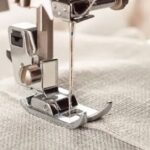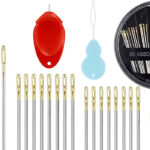Discover the Exciting World of Sewing Patterns!
If you’re passionate about crafting your own clothes, sewing patterns are your go-to resource! They serve as a detailed guide for cutting and stitching fabric pieces together, ensuring that your creations fit perfectly and look fabulous. However, there’s a catch: many patterns are designed for larger paper formats, which can be tricky if you only have access to standard home printers. But worry not! This article is here to help you transform those large patterns into A4 size, ideal for home use. We’ll walk you through the necessary tools, provide easy-to-follow instructions, and share tips to ensure precision—empowering you with this valuable skill!
1. Grasping the Basics of Sewing Patterns
Before we jump into resizing patterns, it’s important to familiarize yourself with the various types available. Patterns generally fall into two categories: commercial (store-bought) and handmade. Each type plays a unique role in garment-making. Typically printed on oversized sheets to accommodate different sizes and styles, commercial patterns can be unwieldy when working at home with limited space and resources. By converting them to A4 size, you’ll find them much easier to manage without sacrificing accuracy or detail.
Sewing patterns are filled with symbols and markings that convey crucial information like grainlines, seam allowances, and notches—all essential for guiding you through cutting and sewing processes. A common challenge is fitting these larger patterns onto smaller sheets without losing detail or proportion. Mastering pattern conversion will give you greater flexibility in your projects.
2. Must-Have Tools and Materials
To resize a sewing pattern for A4 paper effectively, gather these essential tools:
- Your chosen sewing pattern: Whether it’s commercial or handmade, ensure it’s clear and intact.
- A computer equipped with a scanner or digital camera: Digitize your pattern for editing; scanners offer clarity but high-quality cameras work too.
- Editing software: Use programs like Adobe PDF or Microsoft Word—or free options such as GIMP or Inkscape—to resize the pattern.
- An A4-compatible printer: Ensure it’s in good working order.
- Scissors and tape: For cutting out and piecing together pattern sections.
- Ruler and measuring tape: For precise measurements during adjustments.
- Pencil or pen: To jot down any changes or notes on the pattern.
Many of these tools are available on Amazon; explore recommended scanners and printers tailored to meet your sewing needs!
3. Dive into the World of Sewing Patterns!
The journey begins with capturing your sewing pattern digitally, either by scanning it or snapping a high-quality photo. Here’s how to get the best results:
Pattern Prep: Spread your pattern out on a spotless, flat surface. Smooth out any creases—ironing can help if needed—to ensure a flawless scan.
Scanning Magic: When using a scanner, set it to capture images in high quality; 300 DPI is ideal for crisp details! If you’re opting for a digital camera, make sure you have great lighting and position the camera directly above the pattern to avoid any distortion. A tripod can be your best friend here!
Saving Your Masterpiece: Save your scanned image as a PDF or PNG to keep its quality intact. If you’re using photos, transfer them to your computer for further editing magic. By following these steps, you’ll create an easily resizable digital version of your sewing pattern!
4. Time to Tweak Your Pattern in Software!
With your digital pattern ready, let’s dive into resizing it for A4 printing:
File Fun: Open up your favorite editing software and import that beautiful scanned pattern. If it’s new software for you, take a moment to explore its features!
Resizing Adventure: Use the resizing tool in the software to adjust the pattern perfectly to A4 size (210 x 297 mm). Keeping proportions intact is key for ensuring that final garment fits like a dream. Most software lets you lock aspect ratios—super handy!
Scale Check Excitement: Print out a test square measuring 10 cm x 10 cm and measure it with a ruler after printing—it should be spot-on! If not, tweak those dimensions before moving forward.
Detailing Delight: As you resize, keep all markings and notches clear and visible—consider adding annotations too!
5. Get Ready to Print Your Sewing Pattern on A4 Paper!
After resizing comes the exciting part—printing!
Printer Prep Party: Before hitting print, double-check those printer settings—select Actual Size to prevent unwanted scaling and opt for high-quality settings if possible for amazing detail!
Paper Power-Up: Using heavier paper can boost durability; cardstock is fantastic if you’ll be using this pattern repeatedly.
Final Printing Thrill: Once everything’s set up perfectly, print away—and maybe start with one piece first just in case adjustments are needed.
Review Time!: After printing’s done, marvel at what you’ve created while checking there are no missing details or errors from resizing.
6. Putting Together Your A4 Pattern
You’ve printed all your pattern pieces, and now it’s time for the exciting part: assembling them!
Cutting Out the Pieces: Begin by carefully cutting along the edges of each printed piece. Precision is key here, as even tiny mistakes can impact how your garment fits. Make sure to use sharp scissors for neat cuts.
Taping Pieces Together: If your pattern consists of several pieces, arrange them according to the original layout. Align all edges precisely and tape them securely in place. Double-check that all markings, notches, and grainlines match up perfectly. Numbering the pieces can make this process smoother.
Final Adjustments: After assembly, take a moment to review the entire pattern for accuracy. Make any necessary tweaks to ensure everything fits together flawlessly. This is also a great opportunity to jot down notes about any changes you’d like to remember for future projects.
7. Handy Tips for Future Pattern Conversions
To streamline future conversions, consider these valuable tips:
Record Measurements: Maintain a notebook with your measurements and any alterations you make to patterns—this will be incredibly useful down the line.
Use Sturdy Paper: For optimal results, print patterns on durable paper to prevent tearing and extend their life.
Invest in Equipment: If you’re frequently converting patterns, think about investing in a larger format printer that handles bigger paper sizes—it’ll save you time and effort in the long run.
Digital Patterns: Seek out digital patterns designed for A4 printing; many designers now offer these options specifically for home use, eliminating conversion needs altogether.
Practice Makes Perfect: The more you practice converting patterns, the faster and easier it becomes—don’t shy away from experimenting with various types!
Join Sewing Communities: Connect with online sewing groups where experienced sewists share insights and tips—they might have faced similar challenges!
Conclusion
Converting sewing pattern into A4 paper size unlocks endless possibilities for home sewers! With the right tools and techniques at your disposal, adapting larger patterns for standard printers becomes a breeze. By following this guide’s steps diligently, you’ll enhance both your sewing skills and project flexibility immensely! We encourage you wholeheartedly—try converting some of your own patterns today—and don’t forget to share those experiences within our vibrant sewing community! Remember—the more you practice—the closer you’ll get towards mastering pattern conversion like an absolute pro!








